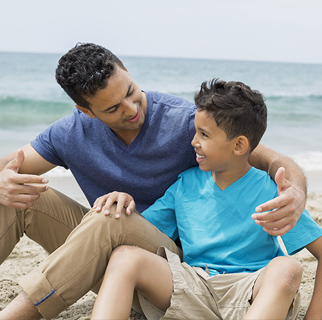Guidelines for Raising Smoke-Free Kids
Guidelines for Raising Smoke-Free Kids
Parents can take practical steps to keep their children smoke-free. At first, young people begin smoking to look cool without understanding the addictive nature of tobacco. E-cigarettes usually contain nicotine and are also considered a tobacco product. But a person who starts smoking when young is likely to continue the habit into adulthood. And quitting smoking later in life is a hard task.
What you can do
Here are specific steps you can take to keep your children from smoking:
If you smoke, quit. Children look to their parents as an example, and children of smokers are more likely to smoke than children of nonsmokers.
Start talking about the dangers of smoking when your children are ages 5 or 6. If you wait until they're 11 or 12, when they're likely to be tempted to try cigarettes, their health attitudes are already pretty well set.
Explain to your children how tobacco advertising manipulates people into believing smoking is cool, socially acceptable and will improve their image. When looking at a billboard, ask your children, "Do you really believe the girl is going to want to kiss the guy after he takes that cigarette out of his mouth?"
Remind them of the cost of smoking. Point out to your children that youngsters who spend money on smoking could have bought CDs, makeup, new clothes, video games, or other things that matter to them.
Pay attention to the friends with whom your children spend time. The chances they'll smoke are greater if they have close friends who smoke. If your children's friends smoke, don't wait until your children start smoking to say something. Bring up the subject first and help them deal with peer pressure.
Get to know the parents of your children's friends. Are they smokers? Do they condone smoking? Are they concerned with raising nonsmoking children? Work with other parents to keep informed about your kids’ activities. And get kids involved in activities that are not connected to smoking. These include organized sports, hiking, biking, or other athletic activities.
Know what you're talking about by becoming well-informed about the dangers of smoking. When talking to your children about smoking, it's important to have the facts. There's no need to exaggerate or to say smoking is worse than it is. The truth is bad enough.
Arm your children with feelings of self-confidence and self-worth. What does self-confidence have to do with not smoking? Everything. Children who feel belittled at home, or who are overly controlled, will seek to escape one way or another. They will often take up smoking to rebel against authority figures.
Tell teens about the negative effects of smoking that may matter most to them at their age. These include bad breath, yellow teeth, and reduced athletic abilities. Teens often don't respond to warnings about the long-term health consequences.
Tell teens about the harmful effects of e-cigarettes. These include serious lung diseases and harmful effects to their developing brains. Other names for e-cigarettes include e-cigs, e-hookahs, mods, vape pens, and tank systems.
Updated:
July 29, 2017
Sources:
Talk with Your Teen About E-cigarettes: A Tip Sheet for Parents. U.S. Dept. of Health and Human Services., THE FACTS on e-cigarette use among youth and young adults. U.S. Dept. of Health and Human Services.
Reviewed By:
Perez, Eric, MD,Taylor, Wanda L, RN, Ph.D.
